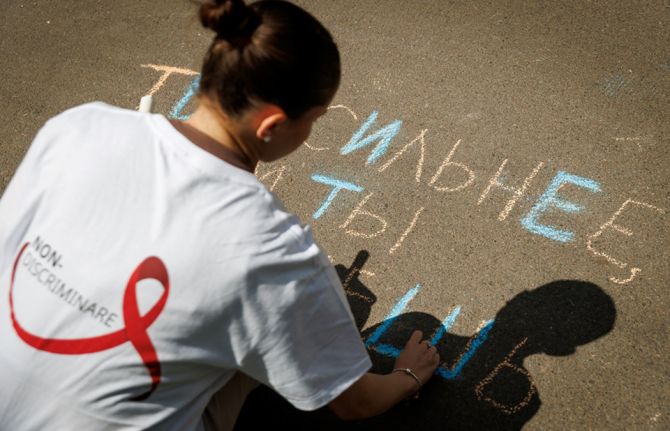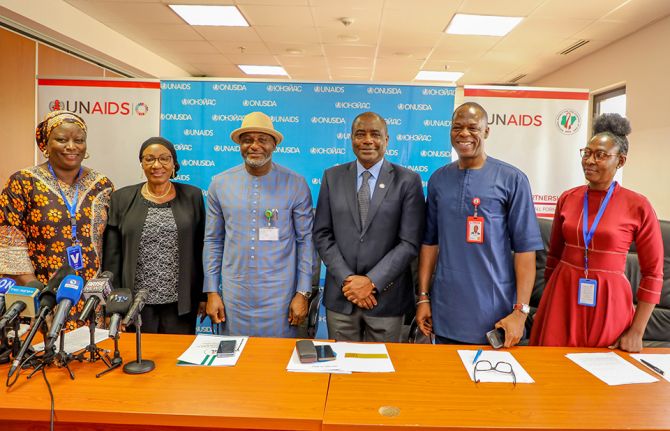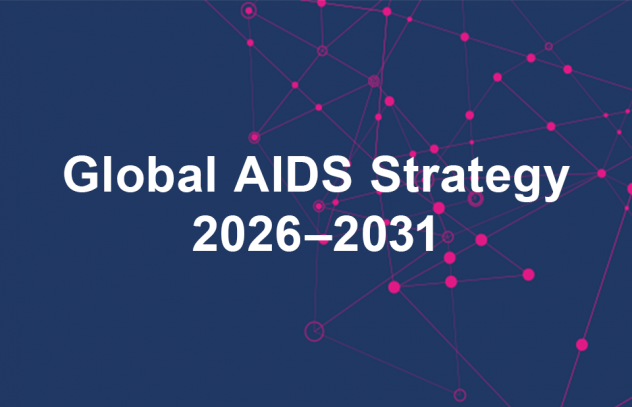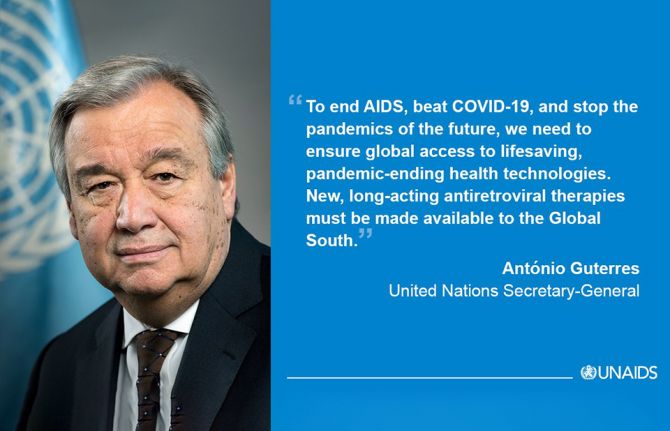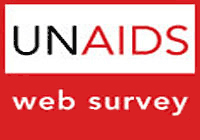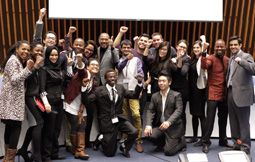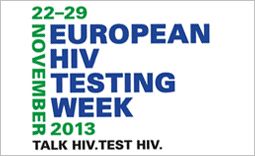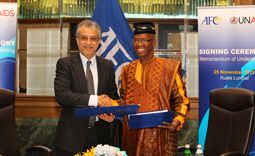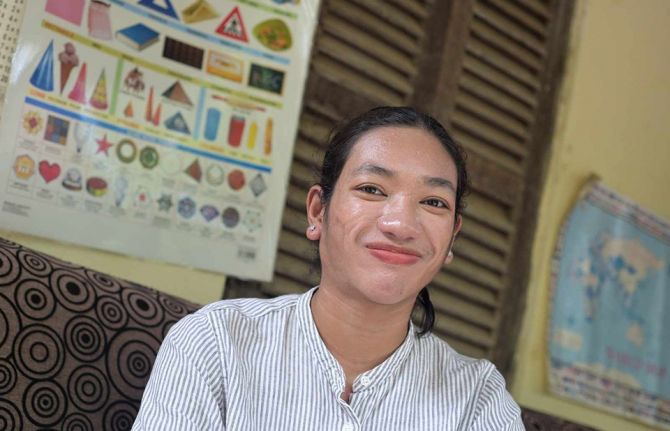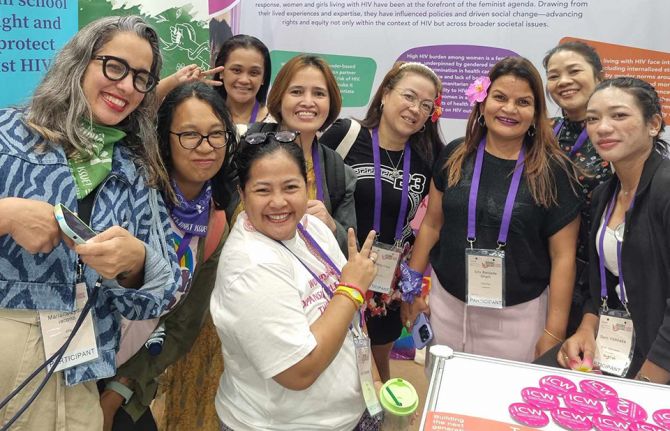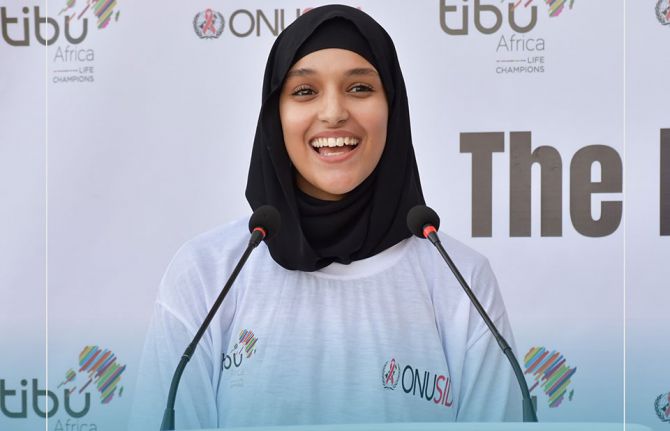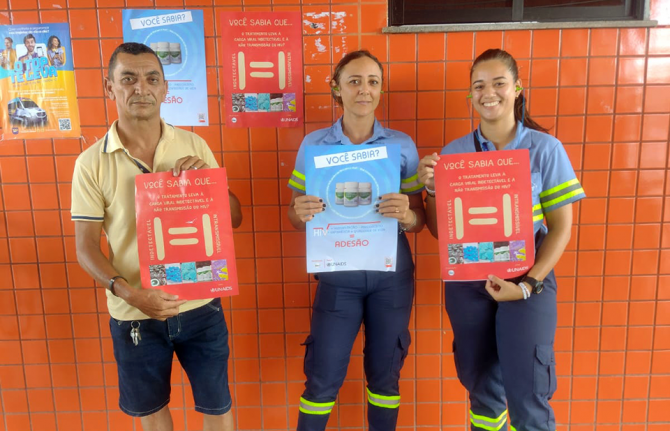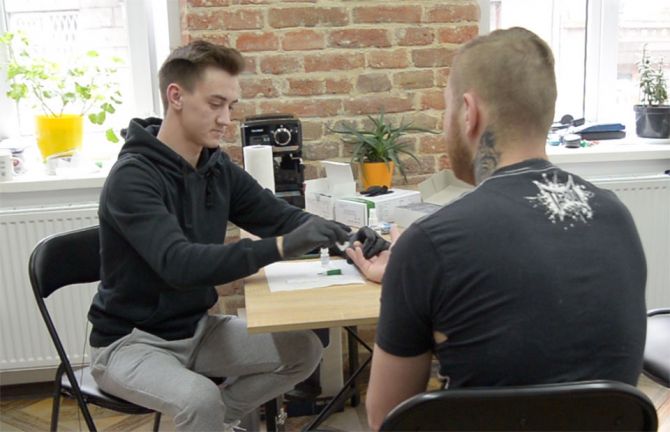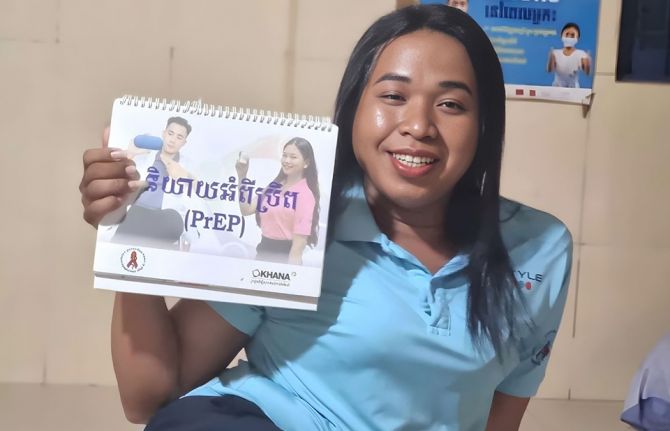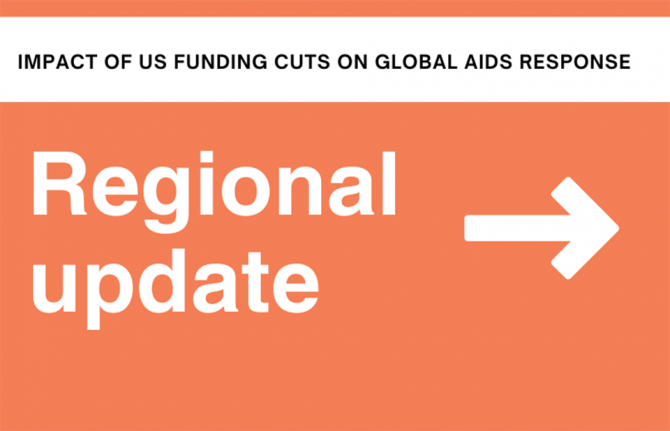
Feature Story
Guyana launches national ‘faith-and-HIV’ coalition
16 December 2008
16 December 2008 16 December 2008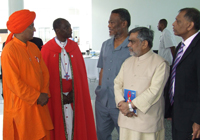 Faith leaders from the Hindu, Christian, Islamic, Rastafarian and Baha’i faiths gathered at the Guyana National "faith-and-hiv" Conference in Georgetown, Guyana, on 11 December 2008.
Faith leaders from the Hindu, Christian, Islamic, Rastafarian and Baha’i faiths gathered at the Guyana National "faith-and-hiv" Conference in Georgetown, Guyana, on 11 December 2008.Credit: UNAIDS
The National AIDS Programme Secretariat of the Ministry of Health in Guyana (NAPS/MOH) convened a National Conference on “faith-and-HIV,” supported by the Joint United Nations Programme on HIV/AIDS (UNAIDS) on 11 December 2008. The aim of the conference was to establish a national coalition of faith leaders of all denominations in Guyana to address HIV-related stigma and discrimination.
At the opening of the 'Guyana National faith-and-HIV Conference', faith leaders from the Hindu, Christian, Islamic, Rastafarian and Baha’i faiths agreed to move from commitment and rhetoric to action, by endorsing the ‘Guyana faith-and-HIV Declaration.’
Through the declaration, faith leaders recognize the need to incorporate appropriate HIV information into their discourses, rituals, religious education, and training of future leaders of faith. They also agreed to safeguard the rights of people living with HIV and affected by HIV, and ensure their complete inclusion in religious, social, familial and economic life.
Furthermore, they pledged to exhort women and their male partners to access formal healthcare, including HIV testing, in recognition of the fact that HIV is a treatable disease and HIV positive parents can have children free from HIV. They also committed to addressing all the vulnerabilities faced by children affected by and living with HIV, especially to ensure that their right to access education, treatment, care, and support in a loving environment is respected.
Finally, they agreed to utilize their places of worship, their educational and health facilities, and their women and youth programmes, to provide the full range of HIV prevention, treatment, care and support services.
During his opening remarks, Health Minister Dr. Leslie Ramsammy emphasized the importance of faith based organizations taking on a more active role in the response to AIDS and pointed to the results of a recent survey which revealed that only 50% of such organizations fully support people living with HIV.

Participants at the Guyana National "faith-and-hiv" Conference, Georgetown, Guyana, 11 December 2008
Credits: UNAIDS
Religious communities, mosques, temples, churches, hospitals and clinics have reached out to provide support to those living with and affected by HIV worldwide. Their leadership has great influence in the lives of many people, and leaders speaking out responsibly about HIV can make a powerful impact at both community and international level. However, the response of the religious community can also be negative. People living with HIV have been stigmatized by some religious leaders and communities of faith. Approaches to HIV prevention methods and attitudes towards people at increased risk of HIV infection such as men who have sex with men, sex workers or injecting drug users have sometimes hindered the response. Much work remains to be done to eradicate HIV-related stigma and discrimination.
Despite goodwill and a commitment to finding ways of working together, there is a gap between good intentions and effective joint action. Misunderstanding of how different faith communities are organized; tolerance and respect of what their followers believe, and how to identify and engage in joint initiatives that transcends organized religion can stand in the way.
The conference was used to guide the discussions through which the faith leadership in Guyana will address the issues of HIV-related stigma and discrimination and how, through the 'Guyana faith-and-HIV Coalition,' a major contribution will be made, in partnership with the National AIDS Programme Secretariat of the Ministry of Health and its partners, to achieve the national targets set towards achieving universal access to HIV prevention, treatment, care and support for all Guyanese, whoever they are, and wherever they are.
“The response to HIV, in any country, is heavily dependent on the broad mobilization of its leaders, institutions and movements. Faith leaders and their communities are present literally everywhere people live their lives - with enormous outreach as well as in-reach. They are important stakeholders in responding to HIV, as they have a strategic advantage in supporting, understanding and accepting people living with HIV, and in playing a crucial role in preventing new HIV infections,” said Dr. Ruben del Prado, UNAIDS Country Coordinator in Guyana.
Faith-based leadership plays an influential role in the efforts to stop the spread of HIV and, as demonstrated in Guyana, this important leadership can be strengthened in partnership with governments, civil society and the international community.
Guyana launches national ‘faith-and-HIV’ coalitio
Feature stories:
Hindu faith leaders commit to AIDS response (18 June 2008)
Developing strategies to work with Faith Based Organizations (10 April 2008)
Publications:
Guyana National Declaration on Faith and HIV (pdf, 112 Kb)
Related

Feature Story
Dr Peter Piot delivers final report to UNAIDS’ governing board as Executive Director
16 December 2008
16 December 2008 16 December 2008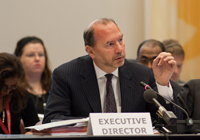
At the 23rd meeting of UNAIDS Programme Coordinating Board (PCB) Dr Peter Piot delivered his final report as Executive Director.
Credit: UNAIDS/D. Bregnard
In what he called his “swan song” Dr Piot gave a concise yet comprehensive review of his tenure at UNAIDS, as well as the AIDS response through his eyes as the first executive director of UNAIDS.
Dr Piot touched on how different it is today in the world to when UNAIDS began in 1996, a time when the world was contributing only US$250 million to AIDS in developing countries and no one was on antiretroviral treatment. He went on to describe achievements in the AIDS response and ended with focus on future issues including leadership and funding, ensuring policies are informed by science, no compromises on human rights, engagement of civil society and the making the money work for people in the most need.
Dr Piot closed by calling on the UNAIDS governing board to give the new Executive Director Mr Michel Sidibé the same support he has received.
Delegations shared their appreciation. Countries and delegations made interventions praising the work of Dr Piot while commenting on the challenges ahead for the AIDS response and assuring Mr Sidibé of their support in the work ahead.
Mr Sidibé thanked the work of the board and thanking the current executive director for his contributions and promised his relentless pursuit of an AIDS reversal.
Dr Piot closed the session by noting that the often in the media you see the conflict of AIDS but what isn’t seen enough is amazing coalition of very different interests. “Where else would you see all these different groups?” he said. He then thanked the PCB Chair, Ambassador Mark Dybul for his leadership and concluded with words from Arundhati Roy:
“To never simplify what is complicated or complicate what is simple. To respect strength, never power. Above all, to watch. To try and understand. To never look away. And never, never, to forget.”
Dr Peter Piot delivers final report to UNAIDS’ go
Speeches:
Speech by UNAIDS Executive Director Peter Piot, to the UNAIDS PCB, 16 December 2008
Speech by Michel Sidibé, who was appointed new UNAIDS executive director taking effect January 1, 2009 to 23rd meeting of the UNAIDS Programme Coordinating Board, 16 December 2008 (pdf, 44 Kb)
Statement of the Committee of Cosponsoring Organizations to the 23rd meeting of the UNAIDS Programme Coordination Board
16 December 2008 (pdf, 30 Kb)
Multimedia:
Watch video of speech by outgoing UNAIDS Executive Director Dr Peter Piot to UNAIDS 23rd meeting of the Programme Coordinating Board, 16 December 2008
View photo gallery from the 23rd meeting of UNAIDS Programme Coordinating Board, Geneva, 15-17 December 2008
Publications:
Decision of the 23rd meeting of UNAIDS Programme Coordinating Board (pdf, 21 Kb)
UNAIDS: First 10 years (pdf, 5.94 Mb)

Feature Story
New UNAIDS Web Survey
12 December 2008
12 December 2008 12 December 2008“UNAIDS is trying to gain insight into our audience and better understand how users of our website feel about the site and the types of content that we have available. The information you provide will help us to assess what additional features are needed and how to improve our web site to make it even more useful in the future.
Your opinions are important to us, so we would be very grateful if you would help us by completing the survey. It should take approximately 5-7 minutes to complete, and all of your responses are completely confidential.”
UNAIDS Web SurveyRelated

Feature Story
Advocating for HIV trials that work for women
11 December 2008
11 December 2008 11 December 2008
Women and girls, who constitute half of all people living with HIV, are often underrepresented in biomedical HIV trials, particularly those assessing new treatment drugs or strategies.
Credit:UNAIDS/P.Virot
Women and girls, who constitute half of all people living with HIV, are often underrepresented in biomedical HIV trials, particularly those assessing new treatment drugs or strategies. When they are included, it may be in numbers that do not allow conclusions to be drawn about them. In spite of biological differences between men and women that can influence drug metabolism, research data may not be disaggregated, analyzed, and reported by sex.
One year ago today, a two-day meeting concluded which marked the beginning of the Women and HIV Trials initiative. This new forum opened a dialogue among peer academics, scientists and policymakers to challenge research norms underpinning the relative invisibility of women in clinical trial design, implementation, and reporting. The event was hosted by four partners, UNAIDS, the Global Coalition on Women and AIDS (GCWA), the International Centre for Research on Women (ICRW), and Tibotec.
A year on, the Women and HIV Trials initiative is generating interest at a global level. “The greatest success of the last year has been the simultaneous, multi-pronged approach to the challenge of the participation of women in HIV trials,” says Karen Manson of Tibotec, co-organizer of the original gathering.
“The Geneva meeting has catalysed many actions and initiatives - some directly the result of working groups that were established at the meeting but many others that are the indirect result of individuals being motivated to push for progress wherever possible.”
A number of strategic areas were identified during the initial 2007 consultation and formulated into an action plan implemented under the themes of: trial design, trial conduct, and reporting of results.
Trials designed with women in mind
In order to get an accurate picture of the participation of women in clinical trials, one of the activities of the last year has been to evaluate progress since 2000 in the proportion of women involved in later phase HIV clinical trials. The “score card” exercise found that publicly funded trials, such as the National Institute of Health (NIH)-sponsored trials in the USA, involve a significantly higher proportion of women participants than privately sponsored trials. The NIH commitment to adequate representation of women in their clinical trials follows on legislation in the USA on the inclusion of women and minorities in government sponsored trials.
“The progress seen in the US as a result of the Public Law revitalization act is indeed good news. However, clearly we still have far to go to meet these standards for HIV treatment trials” said Dr Sharon Walmsley, Professor of Medicine at the University of Toronto, Canada, who presented the results of this exercise at the International AIDS conference in Mexico in August 2008.
Trial recruitment and retention
Persuading women to join clinical trials can be difficult. Where women do enrol in trials, research shows that, due to a range of circumstances, they may drop out early. There is recognition that the involvement of community groups, including women’s groups, in trial design and implementation discussions can improve enrolment and retention. Reaching out to the places where women may gather or making existing trial sites more women-friendly, with child care and flexible schedules for instance, are ways to attract and retain women trial participants.
Trials run with needs of women met
Trial organizers have ethical responsibilities to participants. Clinic trial conduct can affect the health of research subjects. In HIV clinical trials, there is a duty to provide specific health care services, such as HIV prevention measures and access to antiretroviral treatment when it is indicated. For women participants, the health care package offered should also include sexual and reproductive health services, including regular pap smears for cervical cancer and screening for sexually transmitted infections.
“In defining the sexual and reproductive health care package to be provided to women in HIV trials, trial sponsors have the opportunity to do good and do well,” says Anna Forbes, Deputy Director, Global Campaign for Microbicides.

The Women and HIV Trials Initiative aims to stimulate people to think freshly about research practices.
Credit:UNAIDS/P.Virot
Forbes, a member of the “Women and HIV trials” initiative, is working with others to draw up guidance on the elements of a standardized sexual and reproductive health package for HIV trials. She underscored the important of providing acceptable contraceptive, reproductive, and sexual health care services—offered on-site when possible—to boost participant recruitment and retention and improve trial power by minimizing the rate of unintended pregnancies.
“Using trial resources to build sustainable access to such care after the trial is over (for example by training local public health staff and purchasing equipment that can be left for the community’s on-going use) also helps meet trials’ ethical responsibilities to reduce global disparities in access to health care whenever possible through trial conduct itself” says Forbes.
Trials that take into account the wider context of gender
The Women and HIV trials initiative has led to discussions on the role of clinical trials in exploring social factors, such as gender, that may explain differences in responses to an intervention being investigated. The International Center for Research on Women (ICRW) is taking the lead in promoting a social science perspective in trials.
At 2008 International AIDS Conference held in Mexico this summer, at which for the first time a number of satellites were held on “Women and HIV Trials”, ICRW launched a publication on the challenges of recruiting and retaining women in clinical trials.
Geeta Rao Gupta, the head of ICRW and a Steering Group member for the Women and HIV Trials initiative argues: “Clinical trials offer an unparalleled opportunity to collect and report social and behavioural data that can provide a more complete picture of the gender context of the HIV epidemic.”
Trials that report on sex differences
There are a number of differences in the way men’s and women’s bodies work. For example, body mass, hormonal cycles, and rates of metabolism are different by sex. However, when outcomes of trials come out in peer journals, these published scientific articles often do not report trial results by sex. This means that we remain blind to differences in drug levels and dosages in men and women.
The Women and HIV Trials Initiative aims to stimulate people to think freshly about research practices.
“When we set out to raise awareness and interest among a broad array of partners including researchers, community groups, national research sponsors, pharmaceutical companies, international regulatory authorities, and medical journal editors, we discovered there was a real surprise element,” notes UNAIDS Chief Scientific Adviser Catherine Hankins, a driving force behind the initiative.
“Many people told us that they had never thought about this issue before and had no idea that so little is known about sex differences in responses to drugs, including HIV medicines.”
To challenge this and pressure researchers designing trials, sponsors funding trials, and authors writing up trial results, the Women and HIV trials initiative is proposing a list of questions for the consideration of medical journal editors and peer reviewers as they assess trial manuscripts. They include two basic questions:
- Is the study powered to draw conclusions about women? In simpler terms, are the numbers of women enrolled sufficient to allow for statistical analysis and the drawing of conclusions about possible sex differences?
-
Has the data been collected, disaggregated, analyzed, and reported by sex?
CONSORT (Consolidated Standards of Reporting Trials), whose guidelines are an essential reference for authors looking for guidance on how to write up their trial results for publication, has recently added a link on its website to the UNAIDS Women and HIV trials web page.
Next steps
Catherine Hankins reflects on the last year as a successful foundation for continued advocacy with a framework for action and the development of outreach materials - meeting report, brochure, score cards, website. “We have been creating momentum to change research norms so that women are better represented in HIV clinical trials and so that reporting of sex-specific results becomes routine,” she says. One of the important next steps for the Women and HIV Trials initiative, according to steering committee member Karen Manson, will be to demonstrate tangible results:
“Showing that more women are participating or having access to HIV clinical trials will be critical in breaking down the perception that it is an insurmountable challenge.”
Hankins sees a collaborative approach as the key to the consolidation and long-term success of this initiative:
“Our next step is to continue building a network of partners to advocate for placing women and adolescent girls at the centre of HIV clinical research.”
Through this, an impact on the wider epidemic is possible. As Director of the Global Coalition on Women and AIDS Kristan Schoultz states: “If our response to AIDS isn’t working for women - and that includes our response from the clinical trials perspective - it’s basically not going to work at all.”
Advocating for HIV trials that work for women
Partners:
Global Coalition on Women and AIDS
International Centre for Research on Women
Tibotec
Feature stories:
Meeting ethical concerns over HIV trials (3 December 2007)
The role of women in HIV trials (5 December 2007)
Experts meet on women and HIV clinic trials (7 December 2007)
External links:
Science magazine Special Online Collection: Clinical Trials and Tribulations (October 2008)
Speeches:
Contact:
For more information please email womenandtrials@unaids.org
Publications:
Clinical Science Meets Social Science: Gender and AIDS Vaccine Research (ICRW, IAVI) (pdf, 2.70 Mb)
Making HIV trials work for women and adolescent girls (July 2008) (pdf,140 kb )
Gender and Sex-Based Analysis in Health Research: A Guide for CIHR Researchers and Reviewers (Canadian Institutes of Health Research)
Ethical considerations in biomedical HIV prevention trials (pdf, 750kb)
Good participatory practice guidelines for biomedical HIV prevention trials (pdf, 3.04Mb)
Presentations at satellite session XVII International AIDS Conference, Mexico City, August 2008:
Women and Trials in High-Income Settings: Clinical Investigator Perspective
Judith S. Currier (ppt)
What does sexual & reproductive health have to do with clinical trials?
Anna Forbes (ppt)
Women and Trials in Low and Middle-income settings: the clinical investigator’s
Perspective Beatriz Grinsztejn (ppt)
Women and clinical trials: where have we been and where are we going?
Catherine Hankins, Chief Scientific Adviser to UNAIDS (ppt)
Women’s Participation in Clinical Trials - Are we POWERED to meet the Challenge?
Dr Sharon Walmsley (ppt)
Creating Meaningful Research for Women: Issues and challenges from the community perspective
Heidi Nass (pdf)

Feature Story
UNAIDS and International Federation of the Red Cross and Red Crescent renew collaboration
11 December 2008
11 December 2008 11 December 2008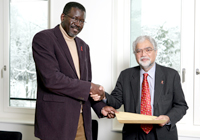
(L to R) Elhadj Amadou Sy, UNAIDS Director of Partnerships and External Relations and Dr Mukesh Kapila, Special Representative of the IFRC Secretary General. Credit: UNAIDS/L. Solberg
The International Federation of the Red Cross and Red Crescent (IFRC) and the Joint United Nations Programme on HIV/AIDS (UNAIDS) renewed their collaboration agreement to work together to scale up efforts for universal access to HIV prevention, treatment, care and support services worldwide.
The partnership, covering a three-year period from 1 January 2009 to 31 December 2011, will focus on two main issues. First, it will pay particular attention to addressing stigma and discrimination related to HIV and secondly, it will also aim to maximise HIV prevention, treatment, care and support efforts in situations of humanitarian crisis.
“This agreement brings together the comparative advantages of both organizations to effectively address the challenges of HIV, particularly in the context of humanitarian conflict situations”, said Elhadj As SY, UNAIDS Director Partnerships and External Relations. “Stigma and discrimination are major barriers towards achieving universal access to HIV prevention, treatment, care and support. Strong partnerships with people living with HIV will help us make a difference,” he added.
To attain the objective of bringing down stigma and discrimination, the IFRC will work in partnership with the Global Network of People living with HIV and AIDS (GNP+), the leading organization that advocates to improving the quality of life of all people living with HIV.
The collaboration between IFRC and GNP+ has been instrumental in the preceding UNAIDS agreement of 2004-2006 by addressing HIV related stigma and discrimination through the national Red Cross Red Crescent Societies.

Credit: UNAIDS/L. Solberg
The promotion and protection of human rights, greater involvement of people living with HIV in the response to AIDS, gender equality and the involvement of civil society in national coordinating and decision making bodies are some of the guiding principles that will drive the collaboration.
“People living with HIV are entitled to the full protection of national laws to uphold their human rights, but even that is not enough. Stigma is still killing people at least as much as AIDS, and so the irrational drivers of this fear and lethal exclusion must be better understood and mediated. Social cohesion is the foundation of effective response to HIV,” said Dr Mukesh Kapila, Special Representative of the Secretary General.
About IFRC
The International Federation of Red Cross and Red Crescent Societies is the world's largest humanitarian organization, providing assistance without discrimination as to nationality, race, religious beliefs, class or political opinions. Founded in 1919, the International Federation comprises member National Red Cross and Red Crescent Societies and a Secretariat working from Geneva and strategic locations around the world. The Federation strives, through voluntary action based on the Fundamental Principles of the Red Cross and Red Crescent Movement, for a world of empowered communities, better able to prevent and alleviate human suffering and advance human development.
About UNAIDS
UNAIDS, the Joint United Nations Programme on HIV/AIDS is the main advocate for global action on the epidemic. It brings together the efforts and resources of ten UN system organizations in the AIDS response: UNHCR, UNICEF, WFP, UNDP, UNFPA, UNODC, ILO, UNECSO, WHO and World Bank. It leads, strengthens and supports an expanded global response aimed at preventing transmission of HIV, providing care and support, reducing the vulnerability of individuals and communities to HIV, and alleviating the impact of the epidemic.
UNAIDS and International Federation of the Red Cr
Partners:
International Federation of the Red Cross and Red Crescent (IFRC)
Publications:
A vital partnership: The work of GNP+ and the International Federation of Red Cross and Red Crescent Societies on HIV/AIDS
UNAIDS Best Practice Collection, October 2003 (pdf, 1.17 Mb)

Feature Story
New generation of health and human rights advocates inspired by Dr Jonathan Mann
10 December 2008
10 December 2008 10 December 2008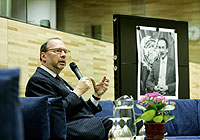
UNAIDS Executive Director Dr Peter Piot, 24 November 2008
Credit: UNAIDS/M. Girardin
“We have lost him, but we have not lost the legacy he left us,” said Justice Michael Kirby of the High Court of Australia of Dr Jonathan Mann, the visionary epidemiologist, advocate and scientist who highlighted the inextricable links between human rights and public health.
In commemoration of Dr Mann's untimely death ten years ago, and to celebrate his legacy and the 60th anniversary of the Universal Declaration of Human Rights, UNAIDS, WHO and OHCHR hosted “HIV, health and human rights: The Legacy of Jonathan Mann Today” on 24 November 2008.
The commemorative event brought friends and former colleagues of the late Dr Mann together with human rights, health and HIV practitioners for a moving tribute.
UNAIDS Executive Director, Dr Peter Piot, spoke of the significance of Jonathan Mann’s influence on shaping the early AIDS response. “If somebody else had been in charge of the global programme on AIDS, they would have created it with other ideas, with old-fashioned public health ideas, such as quarantine and forced testing. The response to AIDS would have been quite different, and it would have been catastrophic,” said Dr Piot.
Seeing the humanity of those affected and marshalling resources on their behalf

Credit: UNAIDS/M. Girardin
Dr Piot explained that Dr Mann was a leader in thinking of HIV as more than a virus, how he “would see immediately the societal and political implications” of the disease. “He was more like a chess player than anything else for knowing and anticipating the next move of the virus, as well as the people who didn’t want to deal with it,” said Dr Piot.
A compelling keynote speech was given by Justice Michael Kirby of the High Court of Australia who advised Dr Mann when he was director of the Global Programme on AIDS. Justice Kirby recalled Dr Mann’s conviction at their first meeting, “AIDS is a women’s issue…a women’s issue because of women’s disempowerment.”
Justice Kirby spoke movingly of Dr Mann’s inspiring leadership, and encouraged UN staff and other guests to continue Mann’s work with the same imagination and courage. He also took the opportunity to thank UNAIDS Executive Director Dr Peter Piot for his own powerful leadership and strong support for human rights in the response to HIV.
A film on Jonathan Mann produced by The Face of AIDS and entitled “Jonathan Mann: Legacy of a Huma Rights Advocate” was premiered at the event. Footage included interviews from the late 1980s in which he explained the unique way in which AIDS both unveils and exacerbates previously existing disadvantage and social challenges, making human rights essential to any HIV response.

Credit: UNAIDS/M. Girardin
Dr Mann’s call for an understanding of the people behind the disease resonated throughout the discussion that followed, illustrating the ongoing significance of his message.
A panel of former peers, moderated by Kevin M. De Cock, Director of the WHO Department of HIV/AIDS reflected on the man they knew and brought his commitment alive for the 140 guests, who represented different generations in the AIDS response.
Jonathan’s tireless advocacy in promoting an inclusive response to HIV by involving people living with HIV, sex workers, people who inject drugs and men who have sex with men was highlighted as contributing to a seismic shift in the way the United Nations and the world responded to HIV .
“In his ear, the voice of a sex worker and the voice of a president had the same weight,” recalled Teguest Guerma, Associate Director of the HIV/AIDS Department at the WHO.
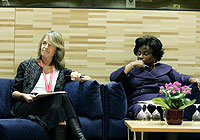
Credit: UNAIDS/M. Girardin
Daniel Tarantola, Professor of Health and Human Rights, University of New South Wales, Australia recalled the fundamental practicality of Jonathan’s message, “He was guided by the practical utility of human rights as a framework for responding to HIV.” He and Sophia Gruskin, Director, Program on International Health and Human Rights at the Harvard School of Public Health, both talked about Dr Mann’s incredible leadership in bringing together, for the first time, HIV and respect for human rights.
It was clear that Dr Mann’s passion was equally inspirational to a younger generation who never knew him. UNAIDS Youth Research Fellow Korey Chisholm described how Dr Mann’s approach of explaining human rights simply and directly to all people will help him when he returns to his home country, Guyana, to build capacity among networks of sex workers and men who have sex with men. Chisholm noted how this approach will enable people to recognize their own rights and be stronger advocates.
Today’s relevance of human rights to health and HIV
Jonathan Cohen from the Open Society Institute moderated a subsequent discussion on the ongoing relevance of human rights to health and HIV in light of some contemporary human rights challenges.
Cohen highlighted the similarity and urgency between Jonathan Mann’s key message in an article he published in 1988 entitled “Health and human rights: if not now, when?”, and the 2007 Declaration signed by over 600 organisations entitled “Human Rights and HIV/AIDS: Now More Than Ever”.
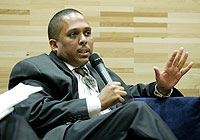
Credit: UNAIDS/M. Girardin
Mark Heyward who is the head of AIDS Law Project and the Deputy Chair of the South Africa National AIDS Council, called for a new direction in the AIDS response based on the recognition of human rights and highlighted the need to move beyond the rhetoric.
Challenging those present to remember Dr Mann’s words as if he were still live today, Gracia Violeta Ross Quiroga from the Bolivian Network of People with HIV/AIDS stressed that his message is as relevant now as it was then. “When did we lose the passion he brought?”
Ross also questioned how the discussion of HIV would be different if Dr Mann were still alive. As Dr Peter Piot pointed out, “Jonathan Mann saw beyond the health condition to the human being. He saw beyond the patient to a sick society”. The same need for such vision remains today.
The event was co-sponsored by the Joint United Nations Programme on HIV/AIDS (UNAIDS), the World Health Organization (WHO) and the Office of the High Commissioner for Human Rights, with guests from UNAIDS secretariat and cosponsors, the Global Fund, as well as other organizations and government missions.
New generation of health and human rights advocat
Cosponsors:
World Health Organization
Office of the High Commissioner for Human Rights
Press centre:
UNAIDS acknowledges the health and human rights legacy of Jonathan Mann on the tenth anniversary of his death (2 September 2008)
Multimedia:
A celebration in honour of Jonathan Mann and the 60th Anniversary of the Universal Declaration of Human Rights (24 November 2008)
Watch video broadcast of this event
Related

Feature Story
ICASA 2008: Social change needed to reduce HIV risk and vulnerability
07 December 2008
07 December 2008 07 December 2008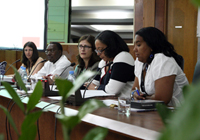
Credit: Jacky Ly
Social issues like gender inequality, violence against women and the criminalization of activities like sex work, injecting drug use and same sex intercourse are factors that can make people more vulnerable to HIV infection. To discuss the challenges of social drivers, UNAIDS Secretariat, UNESCO and the Social Change Communication Working Group held a satellite session at ICASA on Sunday 7 December.
“Programmes to address these social or “structural” factors that make people more vulnerable to HIV take time to produce results. It is urgent that they be adapted to communities’ local needs and be implemented, evaluated, and continuously improved as core parts of national AIDS strategies, operational plans and budgets,” said Barbara de Zalduondo, UNAIDS Chief Division of programmatic priorities support.

Barbara de Zalduondo, UNAIDS Chief Division of programmatic priorities support. Credit: Jacky Ly
UNAIDS consultations in more than 120 countries in 2006 revealed that many obstacles to effective HIV programmes are down to social, legal and political reasons rather than strictly technical ones. Gender inequality and violence against women is a large factor. As is the approach of criminalization of activities such as sex work, injecting drug use and same sex intercourse. The persistence of HIV-related stigma and other violations of human rights are also obstacles.
These social challenges are not new. Although well documented for over two decades, all too often they are not addressed by concrete programmes on a large enough scale in national and sub-national responses to AIDS.
For this reason, the ICASA session brought together experts who have designed, implemented, and measured successful programmes to address gender inequality, sexual violence, HIV related stigma and discrimination and other violations of human rights in multiple African contexts. The experts illustrated programme approaches which go beyond building individual knowledge and motivation to also tackle laws, policies and social norms.
The satellite session was an opportunity for HIV programme planners and and community advocates and donors to discuss effective HIV programming.
Participants shared examples of programmes that are catalyzing and supporting change in harmful social norms, which they can consider for application or adaptation at home.
Experts also exchanged information on existing tools for measuring HIV related stigma and discrimination, gender inequitable norms, and concurrent sexual partnerships. Also, programme examples and evaluation methods and data, were shared and discussed.
The 15th International Conference on AIDS and STIs in Africa (ICASA) closes today in Dakar. Over the last few days, hundreds of African and international delegates have held discussions on HIV developments and trends in the region.
ICASA 2008: Social change needed to reduce HIV ri

Feature Story
Public and private sector partnerships in the AIDS response: An opportunity for innovation and leadership
07 December 2008
07 December 2008 07 December 2008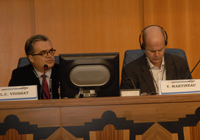 (from left) Ambassador Louis Charles Viossat; Tim Martineau, UNAIDS Director of the Technical and Operational Support Division.
(from left) Ambassador Louis Charles Viossat; Tim Martineau, UNAIDS Director of the Technical and Operational Support Division.Credit: UNAIDS/Mamadou Gomis
Assessing what really works in the AIDS response, and understanding how it works, is all the more pressing in the current context of global financial slowdown said experts at an ICASA session on Friday.
"The current economic downturn leads us to redouble our efforts and look carefully at the effectiveness of programmes and whether or not they are delivering the results we want," stressed Tim Martineau, UNAIDS Director of the Technical and Operational Support Division.
The event, “Public private partnerships against HIV: how can we together turn the tide?” was organized by UNAIDS as part of the conference’s Leadership Programme. Ambassador Louis Charles Viossat chaired a discussion with panelists who included representatives from the Nigerian Business Coalition Against AIDS, Versteergard Frandsen, the Cameroon Business Coalition against AIDS and the United Nations Economic Commission for Africa.
The event explored the benefits and challenges of public-private partnerships in the global response to AIDS.
A public-private partnership (PPP) is defined as an “institutional relationship between the state and the private profit and/or the private non-profit sector, where the different public and private actors jointly participate in defining the objectives, methods and implementation of an agreement of cooperation”. They are characterized by the sharing of common objectives, as well as risks and rewards.
For governments, PPPs can be an opportunity to harness experience in areas where they lack expertise, as well logistical efficiencies that enable better delivery of prevention and treatment services, reducing costs.
For the private sector (profit and non-profit), PPPs may mean a gain in business opportunities, and an enhanced social and economic environment to operate in.
Participants were agreed that attention should be paid to ensure wide participation and representation across the private sector including from the labour unions, employers’ federations, small and medium enterprises and the informal sector. While progress has been seen, there is still a lot to do to improve participation by small and medium enterprises and the informal sector which employ most of the labour force in Africa.
The group identified four factors as critical in creating and sustaining successful PPPs:
- Clear definition of partners’ roles and responsibilities
- Transparency and respect for ethical standards
- Coordination between partners
- Periodic assessments of the partnership
For Ambassador Louis Charles Viossat, "public-private partnerships have proved to be effective and a way forward to better respond to AIDS. However, we need to acknowledge that they are not a silver bullet.”
“Training, information, periodic assessment of the partnership and application of ethical standards are all important," he continued.
Innovation was stressed as a key factor for any public-private partnership to be successful. Navneet Garg, Global Business Manager from Danish company Versteergard Frandsen, "The Millennium Development Goals (MDGs) of stopping the transmission of HIV by 2015 can only be met by using innovative approaches which facilitate rapid scale-up targeting one and all. Public and private partners should utilize their respective strengths and enhance their partnership accordingly. The enormous challenge needs both partners to step up to achieve what is needed to meet the MDGs".
Public and private sector partnerships in the AID
External links:
Official web site of ICASA 2008
Contact:
Marie Engel Partnerships Adviser Private Sector Partnerships UNAIDS Tel: +41 22 791 554 Email : engelm@unaids.org
Related
 Impact of the pause of US foreign assistance in Côte d'Ivoire
Impact of the pause of US foreign assistance in Côte d'Ivoire

19 February 2025

Feature Story
ICASA 2008: Men who have sex with men and HIV in Africa
07 December 2008
07 December 2008 07 December 2008From Cape Town to Lagos, several new studies are starting to provide a better understanding of men who have sex with men (MSM) within the context of HIV in Africa.
“Homosexuality is very much understudied in West Africa, and in Nigeria it is criminalized, making it difficult to reach MSM,” said Sylvia Adebajo, a researcher at the University of Lagos, Nigeria. “As a result, the lives of MSM are characterized by denial, violence, and stigmatization”.
Ms Adebajo was speaking at an ICASA session held yesterday on men who have sex with men and HIV infection in Africa. She said that a significant hurdle in reaching out to MSM in Africa, and in particular in West Africa, is criminalization; few MSM come forward for fear of stigma, discrimination, and legal repercussions.
At this forum researchers presented several findings, some preliminary, that shared similar conclusions: HIV prevalence for MSM is many times higher than ‘background populations’, few self-identified MSM seek medical support or identify themselves in their communities, startling numbers do not wear condoms when having sex, many engage in bisexual behaviour, and few get tested to know their HIV status.
“Many MSM when they finally had a HIV test and it was positive, had not known their status and had continued to engage in high-risk behaviour for some time,” said researcher Earl Ryan Burrell of the Desmond Tutu HIV Foundation. “HIV programmes in South Africa are heavily heterosexual and female focused… more recognition of MSM as a risk group is needed,” he added. His ongoing study in Cape Town and its surrounding townships showed that many MSM are not aware of the risks associated with certain sexual acts, despite self-identifying as MSM and having varying levels of access to HIV prevention information.
A study completed in 2006 in Nigeria revealed that little is known about the link between HIV prevalence and MSM in the country. But of those surveyed nearly all reported having multiple concurrent partnerships with both male and female sexual partners. Condom use was low and when condoms were worn, many men used saliva or soap or oil-based lubricants, such as domestic cooking oil which can damage the surface of condom.
The researchers ended the session by encouraging African governments to invest more resources in supporting HIV prevention and, most importantly, to recognize MSM as a group that requires tailored programmes. “More is needed to be known. Each of these communities have their unique prevention and treatment needs,” said Ms Adebajo.
ICASA 2008: Men who have sex with men and HIV in
Related
 Impact of the pause of US foreign assistance in Côte d'Ivoire
Impact of the pause of US foreign assistance in Côte d'Ivoire

19 February 2025

Feature Story
ICASA 2008 ends with call for stronger youth focus
07 December 2008
07 December 2008 07 December 2008
Ms Souadou N'Doye, a young Senegalese, urged those attending ICASA to ensure that young people are involved in the design of HIV programmes. Credit: UNAIDS/Jacky D. Ly
ICASA 2008 closed on 7 December with a strong message: youth are essential in the response to AIDS in Africa, especially those living with HIV. The closing ceremony began with a statement delivered by Ms Souadou N'Doye, a young Senegalese. She spoke on behalf of all young Africans and urged those in attendance to ensure that young people are involved in the design of HIV programmes.
She asked governments and partners to utilize the talents of young people from each country. Without young people, she stressed the AIDS response is incomplete. "All that is done for us, but without us, is against us," she said.
Professor Souleymane M'Boup, president of the ICASA 2008 organizing committee, expressed his gratitude to the organizers and to participants who travelled from all over the world to attend the Africa-focus AIDS conference. He emphasized his satisfaction in knowing that all people touched by HIV were present at the conference and had a platform to express their concerns, from vulnerable women and sex workers to men who have sex with men and migrants. He said the mosaic of participants made this 15th edition of ICASA a success. Most importantly, Prof M’Boup said he realized over the past five days that “Africa is moving, and that energy and hope are everywhere.” He closed by asking participants to return home with one message – Africa’s AIDS response must be advanced.
The need for a focus on sexual minorities, the greater involvement of youth, religious and military leaders and the urgency to improve HIV prevention programmes have been running themes throughout the conference sessions. A cross-cutting issue was the need for long-term financing. This was identified as a critical aspect for human development in Africa and especially for an effective and sustainable response to AIDS.

The closing ceremony of ICASA 2008, Dakar, 7 December 2008. Credit: UNAIDS/Jacky D. Ly
The ICASA organizers used the closing ceremony to deliver a series of awards to those leaders active in addressing AIDS. UNAIDS Executive Director Dr Peter Piot, Dr Michel Kazatchkine, Executive Director of The Global Fund to Fight AIDS, Tuberculosis and Malaria, and Dr Meskerem Grunitzky-Bekele, Director of the UNAIDS Regional Support Team for West and Central Africa, were among those who were presented with an award from the Senegalese Minister of Health and Prevention, Dr Safiatou Thiam.
ICASA 2008 ends with call for stronger youth focu
Related
 “Who will protect our young people?”
“Who will protect our young people?”

02 June 2025

